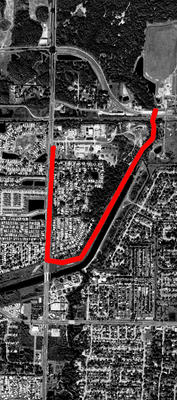"His Dreams Walk About The City Where He Persists Incognito"

title excerpted from W.C. Williams' "Paterson"
North UTBT 3mi
I think that I needed the two days off to rest my legs a bit, and the weekend was pretty hectic anyhow. I’m thinking of swapping my Saturday and Sunday routines so that I run on Sunday. This makes it easier to crosstrain because the gym is always open on Saturday. I think a lot of other training programs have the day off following the long run, and I think this might be more to my liking as well.
Today I was back to work and my training schedule called for crosstraining, but I was feeling a little guilty about skipping the last few days and I felt like I should get some running in. I ran the UTBT three-mile out-and-back route at a nice 11:00 pace. My legs felt tight the whole way, but they never got truly painful.
Cardiovascularly, I am definitely improving, even if musculoskeletally I can’t keep up. My pace this morning felt very comfortable and my heart rate at the split was still only 140. I see more and more how the temperature affects my heart rate, and I would guess that for every degree increase in temperature, my heart rate increases by about two beats per minute. I’m working on developing a formula that shows improved efficiency through training. This would be a measure of heart rate as compared to running pace.
Today I read some of Denis Wood’s writing online, as well as a short story by Barry Lopez titled “The Mappist”. I was struck by the similarities between these real and fictional characters (Denis Wood and Corlis Benefideo), and I began thinking more about what it is that is driving this project of mine. I realize that I still don’t have a distinct focus. I see more and more that my runs function more as reconnaissance than as research. For me to form a truly detailed and comprehensive map, I must read the histories of this city in its books, as well as in its streets and in the mouths and imaginations of its people. As Lopez writes in “The Mappist”, Benefideo’s book is based on the idea that the city is “the living idea of its inhabitants”.
InIra Glass’s interview with Denis Wood he says that Wood’s maps “make the neighborhood seem like a living organism”, to which Wood responds, “It is a living organism!”
Carlo said to me “your aerial maps look like pictures of Hiroshima,” and I saw the brutality in these images. It was not my intent to lay this city to waste. Today I’m thinking of softer representations of this city. I’m imagining a 3-D model on the brick floor of Flight 19 made of Cuban coffee and tobacco leaves. I’m thinking of hand-drawn maps on rag paper, I’m thinking about water; where it moves, collects, rises and falls. And I’m wondering why every city calls itself the “Lightning Capital of the World”.
4 Comments:
Is Tampa not the "lightning capital of the world"? Were we told this as kids to scare us into going inside during storms?
I agree that the aerial maps do not reveal the true character of our city, however, I have learned a little about our city from viewing the maps.
We were lied to. Tampa is not the lightning capital of anything. The STATE of Florida is considered the lightning capital of the US, and the highest number of cloud to ground lightning strikes occurs in the area between Tampa and Titusville. Florida receives about twice as many cloud to ground strikes as any other state, but the casualty rate is three times as high. Hooray for golfers!
By the way, Rwanda is the lightning capital of the world with three times as many thunderstorms per year as Florida.
There is something very sad about "The Mappist". When Mr. Benefideo talks about his maps and the relevance of the history that they contain, I think about all the nuances of life that are taken for granted and forgotten. What was once a house containing the memories of a family is now an abandoned field, or a Trump tower. If you think about it, we are constantly shedding things that 100 years ago we would have thought that we could never do without. In a way it is sad, but change is progress. Like Mr. Benefideo, I want to know the terms. I had a discussion with one of the senior archivists at my job today about the future. He said that it is conceivable that in the future, fifty or a hundred years from now, we may no longer need to expend any effort to research the information that we need. By that time, we may all be connected cerebrally to some super highway of central knowledge. This kind of forecast seems frightening to me because it would mean the elimination of discovery and wonder. The process of map making for Mr. Benefideo is about discovery as well as recording the history of a place at a specific period in time. If we were to lose the ability or need to seek answers, then a huge part of our humaneness would disappear, would it not?
Sounds like a great job.
I've been thinking about mapping campsites at bluegrass festivals for awhile. Each year the same festival grounds are used, but the camp configurations are always changing. There are certain elements that remain unchanged (shade trees, water, outbuildings, etc.) and others that are created anew each year (not only the individual camps, but the paths between them, the parking areas, and even the location of the port-o-lets). An aerial study of these mutations could provide some insight into the identification of likely sites as well as creating a set of guidelines for the planning of future developments.
Post a Comment
<< Home